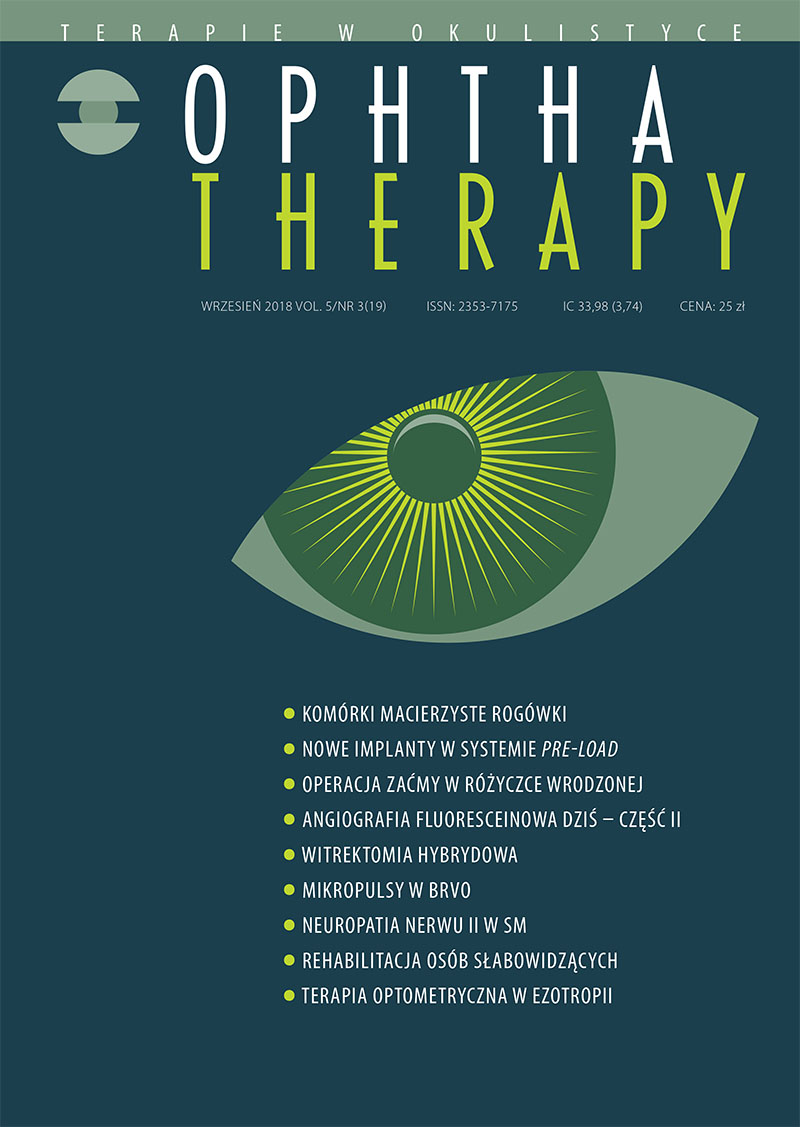Neuropatia nerwu wzrokowego w przebiegu stwardnienia rozsianego i innych chorób neurodegeneracyjnych – metody postępowania diagnostyczno-terapeutycznego
##plugins.themes.bootstrap3.article.main##
Abstrakt
Etiologia stwardnienia rozsianego (SM, sclerosis multiplex) i innych chorób neurodegeneracyjnych jest bardzo złożona. Może się wiązać z wieloma czynnikami działającymi jednocześnie lub kaskadowo. Istotę choroby stanowi wieloogniskowe rozsiane uszkodzenie ośrodkowego układu nerwowego (OUN), które powoduje zróżnicowane objawy neurologiczne i okulistyczne. Częstość występowania wynosi 50/105–100/105 w zależności od szerokości geograficznej. Schorzenia neurodegeneracyjne zależnie od lokalizacji ognisk procesu chorobowego mogą dawać szereg zróżnicowanych objawów okulistycznych. Autorzy przestawiają współczesne spojrzenie na możliwości postępowania diagnostyczno- terapeutycznego u pacjentów z chorobami neurodegeneracyjnymi ze szczególnym uwzględnieniem chorych z neuropatią nerwu wzrokowego w przebiegu SM, podkreślając rolę okulisty i kładąc ogromny nacisk na znaczenie współpracy wielospecjalistycznej w ustalaniu właściwego rozpoznania.
Pobrania
##plugins.themes.bootstrap3.article.details##

Utwór dostępny jest na licencji Creative Commons Uznanie autorstwa – Użycie niekomercyjne – Bez utworów zależnych 4.0 Międzynarodowe.
Copyright: © Medical Education sp. z o.o. License allowing third parties to copy and redistribute the material in any medium or format and to remix, transform, and build upon the material, provided the original work is properly cited and states its license.
Address reprint requests to: Medical Education, Marcin Kuźma (marcin.kuzma@mededu.pl)
Bibliografia
2. Catanzaro R, Anzalone M, Calabrese F et al. The gut microbiota and its correlations with the central nervous system disorders. Panminerva Med. 2015; 57(3): 127-43.
3. Haile Y, Deng X, Ortiz-Sandoval C et al. Rab32 connects ER stress to mitochondrial defects in multiple sclerosis. J Neuroinflammation. 2017; 14: 19.
4. Selmaj K. Stwardnienie rozsiane. Termedia, Poznań 2006: 10-22, 49, 64-5.
5. Bambo MP, Gracia-Martin E, Larrosa JM et al. Evaluation of optic nerve perfusion in optic neuropathies and neurodegenerative diseases. Arch Soc Esp Oftalmol. 2015; 90(4): 153-5.
6. Brown K, DeCoffe D, Molcan E et al. Diet-induced dysbiosis of the intestinal microbiota and the effects on immunity and diseases. Nutrients. 2012; 4: 1095-119.
7. Pula JH, Reder AT. Multiple sclerosis. Part 1: Neuro-ophthalmic manifestations. Curr Opin Ophthalmol. 2009; 20: 467-75. https://doi.org/10.1097/ ICU.0b013e328331913b .
8. Baker LJ, Miller DH, Reingold SC et al. Vision and vision-related outcome measures in multiple sclerosis. Brain. 2015; 138: 11-27.
9. Akaishi T, Nakashima J, Takeshital T et al. Different etiologies and prognoses of optic neuritis in demyelinating diseases. J Neuroimmunol. 2016; 299: 152-7.
10. Torres-Torres R, Sanchez-Dalmau BF. Treatment of acute optic neuritis and vision complaints in multiple sclerosis. Curr Treat Options Neurol. 2015; 17: 328.
11. Kupersmith MJ, Garvin MK, Wang JK et al. Retinal ganglion cell layer thinning within 1 month of presentation for optic neuritis. Mult Scler. 2016; 22(5): 641-48.
12. Bernstein SL, Miller NR. Ischemic optic neuropathies and their models: disease comparisons, model shenaths and meakness. Jpn J Ophthalmol. 2015; 59: 135-47.
13. Trobe JD. Rapid Diagnosis in Ophthalmology: Neuro-Ophthalmology. Mosby, UK/USA 2008: 23-83.
14. Nordmann JP. OCT and optic nerve Non-glaucomatous optic neuropatienes. La poratoire Thea 2016: 88-115.
15. Bisht B, Darling WG, Grossmann RE et al. A multimodal intervention for patients with secondary progressive multiple sclerosis: feasibility and effect on fatigue. J Altern Complement Med. 2014; 20(5): 347-55.
16. Ghadiri N, Emamnia N, Ganjalikhani-Hakemi M et al. Analysis of the expression of mir-34a, mir-199a, mir-30c and mir-19a in peripheral blood CD4+T lymphocytes of relapsing-remitting multiple sclerosis patients. Gene. 2018; 659: 109-17.
17. Cennamo G, Romano MR, Vecchio EC et al. Anatomical and functional retinal changes in multiple sclerosis. Eye. 2016; 30(3): 456-62.
18. Hamurcu M, Orhan G, Sarıcaoğlu MS et al. Analysis of multiple sclerosis patients with electrophysiological and structural tests. Int Ophthalmol. 2017; 37(3): 649-53. https://doi.org/10.1007/s10792-016-0324-2.
19. AL-Louzi OA, Bhargava P, Newsome SD et al. Outer retinal changes following acute optic neuritis. Mult Scler. 2016; 22(3): 362-72.
20. Sühs KW, Papanagiotou P, Hein K et al. Disease activity and conversion into multiple sclerosis after optic neuritis is treated with Erythropoietin. Int J Mol Sci. 2016; 17: 1666.
21. Pojda-Wilczek D, Wycisło-Gawron P. The effect of the decrease in intraocular pressure on optic nerve function in patients with optic nerve drusen. Ophthalmic Res. 2017 Oct 31. https://doi.org/10.1159000481534.
22. Iester M, Altieri M, Michelson G et al. Retinal peripapillary blood flow before and after topical brinzolamide. Ophthalmologica. 2004; 218: 390-6.
23. Barnes GE, Li B, Dean T et al. Increased optic nerve head blood flow after 1 week of twice daily topical brinzolamide treatment in Dutch-belted rabbits. Surv. Opthalmol. 2000; 44(suppl 2): 131-40.
24. Reese D, Shivapour ET, Wahls T et al. Neuromuscular electrical stimulation and dietary interventions to reduce oxidative stress in a secondary progressive multiple sclerosis patient leads to marked gains in function: a case report. Cases J. 2009; 2: 7601.

